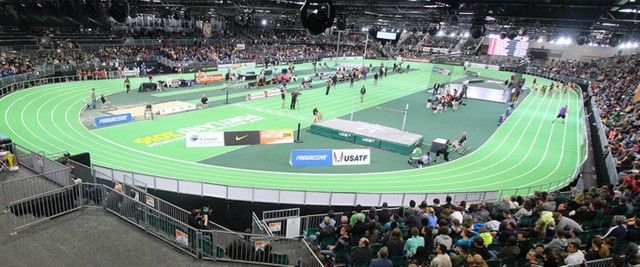Via PUPN Magazine - Click Here
Last winter, a six-lane, 200-meter indoor banked track found itself at the center of the track and field world during a series of high performance meets set in a historic industrial warehouse in Portland, Oregon.
The indoor track was originally commissioned by TrackTown USA, and built in just 20 days, to anchor the USATF Indoor Championships and other international meets across town at the Oregon Convention Center in March 2016. The industrial site was initially intended to serve as only a short-term construction site for the high-speed track, which would be moved across the Willamette River for the big events. Yet, prior to disassembling the track into 1,400 pieces, the space quickly became a celebrated fieldhouse as organizers recognized that weekend meets could be staged for the public to enjoy. Oregon is, after all, the epicenter of the track and field universe.
Some of the biggest names in the sport flocked from across the country to join in the widely publicized Friday and Saturday night track meets in January; and to test out the surface prior to their March competitions. The verdict was unanimous: this track was fast—and forgiving. Spectators came out in droves to see both the engineering and the world-class track and field celebrities. Regional media lovingly dubbed the venue as the “Underground Track” or “‘Fight Club’ of Track and Field.” Children, amateurs and collegiate athletes were also invited to participate in the scheduled public meets. The city was in love with the “House of Track” and the idea of an indoor track venue in Portland.
Beynon Sports built the customized track anchoring the events in just fewer than three weeks. They also constructed the University of Oregon’s renowned Hayward Field track. The legendary Hayward Field attracts coaches and athletes—as well as fans —from across the United States. Their grandstands are comparable to famous European venues, and it has been called "The Carnegie Hall" of American track and field. It also hosts the nation's best single-day track and field contest every year, the Prefontaine Classic. The Portland track covered over 40,000 square feet and was leased to TrackTown by the company for the major events scheduled for March. After its Portland debut, the bright green track was slated to be sold to another university for permanent installation.
Engineering and building this indoor track’s state-of-the-art polyurethane surface and precision steel frame was no easy task. The project involved over 2,000 tons of steel and was constructed for high performing athletes who train extensively and needed a surface that would allow them to have record-breaking times, but be safe for daily use. The excitement around an indoor track in Portland is similar to a trend happening in communities across the country. Indoor track and field is most certainly having a moment.
The importance of climate-controlled spaces with high performance indoor surfaces are increasingly valued by NCAA programs and athletes; for many reasons. Private and public universities across the country have been upgrading or installing indoor tracks now more than ever.
The uptick is a result of any number of factors:
Indoor track facilities are essential recruiting tools for drawing top athletes—most especially in the northern states
An onsite indoor track and field can reduce travel days for athletes – more “home” meets can be scheduled
A track & field facility can serve as an additional revenue source by hosting state, community and regional meets, year-round
Indoor facilities are an excellent way to give back to local communities: fieldhouses naturally become the hub of a local community
Improved athletic performance is nurtured. Modernized and state-of-the-art indoor surfaces provide a greater return of energy and allow athletes to train with reduced risk of injuries when compared to traditional rolled rubber systems.
As indoor track and field evolves, it has become important to consider indoor air quality for the student community and athletes. The best indoor systems are GreenGuard Gold certified and provide superior indoor air quality with little to no daily maintenance.

